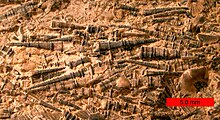Tentaculites: Difference between revisions
m WP:CHECKWIKI error fixes + general fixes using AWB (7926) |
Citation bot (talk | contribs) m [394]Add: year. Tweak: unused_data. Combined duplicate references. | AManWithNoPlan |
||
| Line 1: | Line 1: | ||
{{Automatic taxobox |
{{Automatic taxobox |
||
| fossil_range = {{fossil range | Early Ordovician | Late Devonian | ref={{ |
| fossil_range = {{fossil range | Early Ordovician | Late Devonian | ref=<ref name="Traverse2007">{{cite doi|10.1007/978-1-4020-5610-9_1}}</ref> }} |
||
| image = TentaculitidDevonian.jpg |
| image = TentaculitidDevonian.jpg |
||
| image_caption = Tentaculitids from the [[Devonian]] of [[Maryland]]. |
| image_caption = Tentaculitids from the [[Devonian]] of [[Maryland]]. |
||
| Line 6: | Line 6: | ||
}} |
}} |
||
'''Tentaculites''' is an extinct genus conical fossil of uncertain affinity, known from Lower Ordovician to the Upper Devonian deposits |
'''Tentaculites''' is an extinct genus conical fossil of uncertain affinity, known from Lower Ordovician to the Upper Devonian deposits<ref name="Traverse2007" /> both as calcitic shells with a brachiopod-like microstructure<ref name="Towe1978">{{cite doi|10.1126/science.201.4356.626}}</ref> and carbonaceous 'linings'.{{cite journal |
||
| year = 2004 |
|||
| unused_data = Wood, G.D., Miller, M.A., and Bergstrom, S.M. Late Devonian (Frasnian) tentaculite organic remains in palynological preparations, Radom−Lublin region, Poland. Memoirs of the Association of Australian Palaeontologists 29: 253–258.}}<ref name="Filipiak2009">{{cite doi|10.4202/app.2009.0111}}</ref> The "tentaculites" (i.e. tentaculita) are also referred to as the '''styliolinids'''. |
|||
== Affinity== |
== Affinity== |
||
The taxonomic classification of tentaculitids is uncertain, but some group them with [[pteropod]]s. They may also be related to other conical shells of uncertain affinity including [[Cornulitida|cornulitids]], [[Microconchida|microconchids]] and [[Trypanoporida|trypanoporids]]. |
The taxonomic classification of tentaculitids is uncertain, but some group them with [[pteropod]]s. They may also be related to other conical shells of uncertain affinity including [[Cornulitida|cornulitids]], [[Microconchida|microconchids]] and [[Trypanoporida|trypanoporids]]. |
||
Their shell microstructure has warranted their comparison with the [[brachiopod]]s and [[phoronid]]s. |
Their shell microstructure has warranted their comparison with the [[brachiopod]]s and [[phoronid]]s.<ref name="Towe1978" /> |
||
== Morphology == |
== Morphology == |
||
Tentaculitids have ribbed, cone-shaped shells which range in length from 5 to 20 mm. Some species septate; their embryonic shell, which is retained, forms a small, sometimes spherical, chamber. |
Tentaculitids have ribbed, cone-shaped shells which range in length from 5 to 20 mm. Some species septate; their embryonic shell, which is retained, forms a small, sometimes spherical, chamber.<ref name="Filipiak2009" /> |
||
==Ecology== |
==Ecology== |
||
Revision as of 00:16, 25 April 2012
| Tentaculites Temporal range:
| |
|---|---|

| |
| Tentaculitids from the Devonian of Maryland. | |
| Scientific classification | |
| Domain: | Eukaryota |
| Kingdom: | Animalia |
| Class: | †Tentaculita |
| Order: | †Tentaculitida |
| Family: | †Tentaculitidae |
| Genus: | †Tentaculites von Schlotheim 1820 |
Tentaculites is an extinct genus conical fossil of uncertain affinity, known from Lower Ordovician to the Upper Devonian deposits[1] both as calcitic shells with a brachiopod-like microstructure[2] and carbonaceous 'linings'.. 2004. {{cite journal}}: Cite journal requires |journal= (help); Missing or empty |title= (help); Unknown parameter |unused_data= ignored (help)[3] The "tentaculites" (i.e. tentaculita) are also referred to as the styliolinids.
Affinity
The taxonomic classification of tentaculitids is uncertain, but some group them with pteropods. They may also be related to other conical shells of uncertain affinity including cornulitids, microconchids and trypanoporids. Their shell microstructure has warranted their comparison with the brachiopods and phoronids.[2]
Morphology
Tentaculitids have ribbed, cone-shaped shells which range in length from 5 to 20 mm. Some species septate; their embryonic shell, which is retained, forms a small, sometimes spherical, chamber.[3]
Ecology
Some species are inferred to have been planktonic.[4]
References
- ^ a b Attention: This template ({{cite doi}}) is deprecated. To cite the publication identified by doi:10.1007/978-1-4020-5610-9_1, please use {{cite journal}} (if it was published in a bona fide academic journal, otherwise {{cite report}} with
|doi=10.1007/978-1-4020-5610-9_1instead. - ^ a b Attention: This template ({{cite doi}}) is deprecated. To cite the publication identified by doi:10.1126/science.201.4356.626, please use {{cite journal}} (if it was published in a bona fide academic journal, otherwise {{cite report}} with
|doi=10.1126/science.201.4356.626instead. - ^ a b Attention: This template ({{cite doi}}) is deprecated. To cite the publication identified by doi:10.4202/app.2009.0111, please use {{cite journal}} (if it was published in a bona fide academic journal, otherwise {{cite report}} with
|doi=10.4202/app.2009.0111instead. - ^ LARSSON K. (1979).-. "Silurian tentaculitids from Gotland and Scania". Fossils and Strata, Oslo, vol. 11, 180 p.
{{cite journal}}: CS1 maint: numeric names: authors list (link)
Further reading
- Treatise on Invertebrate Paleontology, Part W - Miscellanea. Geological Society of America and University of Kansas Press, 1962. LCCN 53012913

